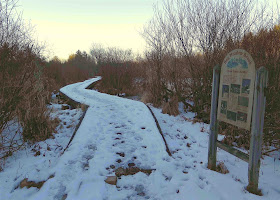But our winter weather did not cooperate. Every other day of the week this month could be lovely, but Thursdays seem to be cursed with nasty weather. February 6 brought freezing rain and hazardous road conditions, and we all stayed home. I offered to lead the same walk two weeks later, but this time the snow was so deep and untrodden we would exhaust ourselves breaking trail. So we canceled again. And now, after days of unseasonal warmth, I fear the lake ice may soon be unsafe to walk on, and I certainly don't want to lead my friends to a watery death. Oh well. Maybe next year.
At least I myself had a chance to explore this site, since the day that I went to preview our walk was pleasant enough, and I easily walked through the light snow cover without the need for snowshoes.
The forest that lines the road to the lake is remarkable for the number and size of Black Cherry trees, immediately recognizable by bark that has been described as resembling "burnt potato chips."
Former human habitation is made evident by the presence of old cellar holes.
Out on the lake, mounds of sphagnum moss could be seen at the base of the shrubs that cover these rocky islets. Leatherleaf (Chamaedaphne calyculata) and Sweet Gale (Myrica gale) are the two most populous shrubs out here, and I detect evidence of both shrubs protruding from this mossy mound.
True to its common name, Leatherleaf holds onto its leathery leaves throughout the winter, on the same twigs where buds for the early blooming flowers are also in evidence.
The open seedpods produced by last year's Leatherleaf flowers also could be mistaken for flowers at first glance.
Sweet Gale twigs hold the glossy brown buds of its spring-blooming flowers, each scale of the buds outlined in white.
Some of the Sweet Gale shrubs display the remnants of last year's female flowers with these spiky seedpods . A pinch of these pods will scatter the seeds on the snow and scent your fingertips with the delightfully aromatic fragrance that suggested this shrub's common name.
The third most populous shrub on these islets is Sheep Laurel (Kalmia angustifolia), with evergreen leaves that often take on a ruddy hue in winter. In the spring, these shrubs will produce abundant clusters of bright-pink flowers.
The deep-red "pitchers" of Northern Pitcher Plants (Sarracenia purpurea) can be found protruding well above the snow. I also see the tiny trailing evergreen leaves of Small Cranberry (Vaccinium oxycoccos) at the base of the central pitcher.
The remains of the Northern Pitcher Plant flowers also persist through the winter, towering over the snow-covered ice.
Most of the herbaceous flowers that thrive on these islets during the warmer seasons completely disappear under the snow, so I was surprised to still find these seed-pod-bearing stalks of Horned Bladderwort (Utricularia cornuta) still in evidence. By now, I could find no trace of the Spatulate Sundews or Rose Pogonia orchids that share the muddy verges of these islets with the yellow-flowered bladderworts. To see some of the flowering plants in all their summer gorgeousness, you can visit this blog I posted after I received permission from the state park to conduct a survey of the plants that thrive on these islands.
I had dreamed that when I led my friends in the Thursday Naturalists here this month, it might be a lovely blue-sky day, with a bright sun warming these boulders on the south-facing shore of the lake, and we could perch here to enjoy a winter picnic overlooking this beautiful lake. Ah well, we could do that next spring or summer or fall, but it's only in winter, when the ice is thick, that we can explore those sphagnum-covered islands. As I said before, maybe next year.














































